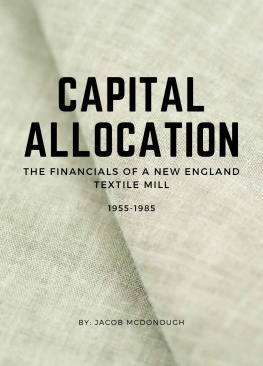Jacob McDonough - Capital Allocation: The Financials of a New England Textile Mill 1955 - 1985
Here you can read online Jacob McDonough - Capital Allocation: The Financials of a New England Textile Mill 1955 - 1985 full text of the book (entire story) in english for free. Download pdf and epub, get meaning, cover and reviews about this ebook. genre: Business. Description of the work, (preface) as well as reviews are available. Best literature library LitArk.com created for fans of good reading and offers a wide selection of genres:
Romance novel
Science fiction
Adventure
Detective
Science
History
Home and family
Prose
Art
Politics
Computer
Non-fiction
Religion
Business
Children
Humor
Choose a favorite category and find really read worthwhile books. Enjoy immersion in the world of imagination, feel the emotions of the characters or learn something new for yourself, make an fascinating discovery.
- Book:Capital Allocation: The Financials of a New England Textile Mill 1955 - 1985
- Author:
- Genre:
- Rating:3 / 5
- Favourites:Add to favourites
- Your mark:
- 60
- 1
- 2
- 3
- 4
- 5
Capital Allocation: The Financials of a New England Textile Mill 1955 - 1985: summary, description and annotation
We offer to read an annotation, description, summary or preface (depends on what the author of the book "Capital Allocation: The Financials of a New England Textile Mill 1955 - 1985" wrote himself). If you haven't found the necessary information about the book — write in the comments, we will try to find it.
Jacob McDonough: author's other books
Who wrote Capital Allocation: The Financials of a New England Textile Mill 1955 - 1985? Find out the surname, the name of the author of the book and a list of all author's works by series.
Capital Allocation: The Financials of a New England Textile Mill 1955 - 1985 — read online for free the complete book (whole text) full work
Below is the text of the book, divided by pages. System saving the place of the last page read, allows you to conveniently read the book "Capital Allocation: The Financials of a New England Textile Mill 1955 - 1985" online for free, without having to search again every time where you left off. Put a bookmark, and you can go to the page where you finished reading at any time.
Font size:
Interval:
Bookmark:
Capital Allocation The Financials of a New England Textile Mill 1955 1985 By: Jacob McDonough McDonough Publishing, LLC 2020 All Rights Reserved. ISBN: 9798631760202 / This book contains some direct quotes from the annual reports of Berkshire Hathaway, Blue Chip Stamps, Wesco Financial, and GEICO. This book also contains direct quotes from the Letters to Shareholders written by Warren Buffett and Charlie Munger. These quotes have been printed with the permission of Warren Buffett and Charlie Munger. / Table Of Contents I. The Preface 4 II.
The Prologue 7 III. The Textile Mill 1955 - 1962 12 IV. The Investment 1962 - 1965 23 V. The Transition 1965 - 1967 27 VI. The Acquisitions 1967 - 1969 39 VII. The Expansion 1970s 67 VIII.
The Other Companies 93 IX. The Conglomerate 137 X. The Conclusion 159 / I. The Preface / It is dangerousto apply to the future inductive arguments based on past experience, unless one can distinguish the broad reasons why past experience was what it was. John Maynard Keynes 1 Berkshire Hathaway is one of the greatest companies in the history of the world. Much has been written about both Warren Buffett and Berkshire explaining this point.
This book is not an attempt to replace or rephrase any of those great works, but instead to supplement them. Readers of this book are encouraged to first read Warren Buffetts Letters to Berkshire Hathaway Shareholders, as well as some of the biographies written about Buffetts life. When a person is considering making an investment, much time and effort is spent analyzing financial data. However, people often rely on more generalized storytelling to analyze past investments. The goal of this book is to bridge that gap. Capital Allocation attempts to analyze Berkshire through the years from the perspective an investor might have had at that point in time.
When preparing for upcoming games, U.S. football teams watch actual game film instead of viewing the SportsCenter highlights on ESPN. History books tend to be more like the highlights, showing the quarterback launching the ball and then the receiver celebrating in the endzone with a creative touchdown dance. This is not a criticism of history books, as generalized storytelling can be very beneficial for a broad audience, especially for those with little expertise in the subject. However, the highlights are of little use to the practitioner who needs to make decisions in the future. A football coach reviews film to see how a lineman picked up a block when a linebacker was blitzing, allowing for enough time for the quarterback to make the throw.
A quarterback reviews footage of the defense to see how they adjusted their coverage when a receiver runs a certain route. Capital Allocation was written for practitioners who wish to analyze more of the finer details of Berkshire as a company. / While this book isnt for everyone, I felt that more attention should be given to the companys financial statements and annual reports. The goal was to give readers a chance to view some of the important information that Warren Buffett viewed when making operating and investing decisions. This is the book I wish I had while learning about the greatness of Berkshire Hathaway. I would like to highlight three items to keep in mind when reading this book.
First, I am a huge fan of Berkshire and Warren Buffett, and I am sure that this admiration caused me to be biased in some way. Second, hindsight is another bias that this book is sure to suffer from. Hindsight can be blinding as it makes things seem more obvious today than they really were at the time. Events should be judged based on their probabilities not their outcomes, but that can be difficult when the outcome is staring you in the face. I tried to look at each detail with a fresh perspective, but I am sure these biases influenced my writing. Third, every investment opportunity needs to be weighed against all other options available to the investor at that time.
The opportunity cost is a crucial part of any investment decision. While I researched Berkshire and some of the companies it invested in, investors during this time period also needed to take into account the opportunity cost of missing out on other options. The decisions to not invest in certain companies might have been more important than the investment decisions Berkshire did make. Other than considering interest rates during the time period, fully incorporating opportunity cost into this book was not feasible. / II. The Prologue / In the 1960s, Warren Buffett invested heavily in a company called Berkshire Hathaway.
The business was struggling, and the industry was in the midst of a steady decline. The company had no real competitive advantages to begin with, and would not be able to compete with cheaper labor overseas. In addition to Berkshire, Buffett also owned a stake in the Diversified Retailing Company as well as a firm called Blue Chip Stamps. Diversified Retailing merged with Berkshire in 1978, and Blue Chip followed suit and merged in 1983. Diversified Retailing was formed by Buffett, Charlie Munger, and Sandy Gottesman to acquire a Baltimore department store called Hochschild Kohn. Blue Chip was a publicly traded company that operated a rewards program with retailers.
Hochschild Kohn went out of business in 1984 after struggling to compete with the rise of discount retailers. Berkshires textile operations were shut down the following year. Blue Chip saw its trading stamp revenue decline 92.6% from $124.2 million in 1969 1 to $9.2 million in 1982 2 . The Berkshire Hathaway in which Buffett built his fortune basically started with these three failed businesses. Despite these headwinds and missteps, Buffett was able to turn Berkshire Hathaway into one of the most valuable companies in the history of the world. How could this be possible? Buffett took control of Berkshire in 1965.
The companys market value reached $21.7 million the year before 3 . At the end of 2019, the market value of Berkshire was about $553.5 billion. This means that Berkshire grew to be 2,550,930% or 25,509 times more valuable than when Buffett took over. Berkshires market value grew at a compound annual growth rate of 20.3% over the 55 year period. The top ten companies in the 1965 Fortune 500 are listed in the following table 4 . This table is sorted by revenue.
Berkshire Hathaway was nowhere close to making it into this list in 1965. Gulf Oil, the 10th ranked company 8 / on the list, had revenue that was 64 times higher than Berkshire and profits that were 173 times higher than Berkshire. 1965 Fortune 500RevenuesProfits 1) General Motors $16,997,000,000 $1,734,800,000 2) Standard Oil of New Jersey $10,814,700,000 $1,050,600,000 3) Ford Motor $9,670,800,000 $505,600,000 4) General Electric $4,941,400,000 $237,300,000 5) Mobil $4,499,400,000 $294,200,000 6) Chrysler $4,287,300,000 $213,800,000 7) U.S. Steel $4,077,500,000 $236,800,000 8) Texaco $3,573,800,000 $577,400,000 9) International Business Machines $3,239,400,000 $431,200,000 10) Gulf Oil $3,174,300,000 $395,100,000 N/A - Berkshire Hathaway $49,300,685 $2,279,206 Berkshire ranked 4 th by revenue in 2019 in the Fortune 500. The change from 1965 to 2019 was almost unbelievable, especially when you compare them to General Electric (GE), for example. In 1965, GE had what appeared to be an insurmountable lead over Berkshire.
GE can trace its roots back to Thomas Edison and the invention of the light bulb, while Berkshire just manufactured textiles. GE had revenues of $4.9 billion and profits of $237.3 million in 1965. Both of these metrics happen to be about 100 times larger than Berkshire, which had $49.3 million of revenues and $2.3 million of profits that year 5 . GE would also be fortunate enough to have Jack Welch as CEO for 20 years starting in 1981. Many consider Welch to be one of the greatest business leaders of all-time. Fortune magazine, for example, named him Manager of the Century in 1999.
Next pageFont size:
Interval:
Bookmark:
Similar books «Capital Allocation: The Financials of a New England Textile Mill 1955 - 1985»
Look at similar books to Capital Allocation: The Financials of a New England Textile Mill 1955 - 1985. We have selected literature similar in name and meaning in the hope of providing readers with more options to find new, interesting, not yet read works.
Discussion, reviews of the book Capital Allocation: The Financials of a New England Textile Mill 1955 - 1985 and just readers' own opinions. Leave your comments, write what you think about the work, its meaning or the main characters. Specify what exactly you liked and what you didn't like, and why you think so.








